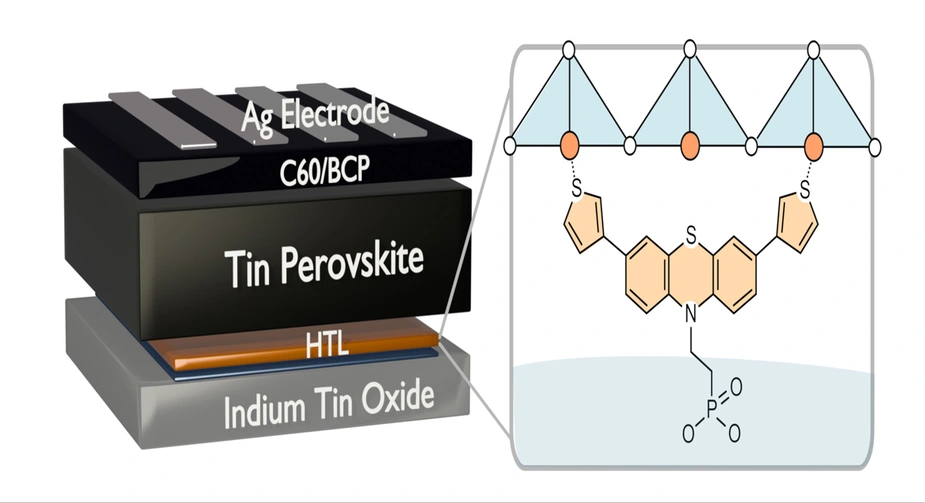Self assembling monolayer can improve lead-free perovskite solar cells too
At HZB, the performance of non-toxic tin perovskite photovoltaics was increased through targeted molecular design
Tin perovskite solar cells are not only non-toxic, but also potentially more stable than lead-containing perovskite solar cells. However, they are also significantly less efficient. Now, an international team has succeeded in reducing losses in the lower contact layer of tin perovskite solar cells: The scienstists identified chemical compounds that self-assemble into a molecular layer that fits very well with the lattice structure of tin perovskites. On this monolayer, tin perovskite with excellent optoelectronic quality can be grown, which increases the performance of the solar cell.
Perovskite semiconductors are an exciting new material for use in solar cells. They are extremely thin and flexible, easy and inexpensive to manufacture, and highly efficient. However, two hurdles must be overcome before perovskite solar cells can be marketed on a large scale: firstly, they are not yet stable over decades, and secondly, the most powerful perovskite materials contain lead. An interesting, non-toxic alternative being investigated at HZB is tin perovskite solar cells, which are potentially more stable than their lead-containing counterparts. Thanks to their special electro-optical properties, they are particularly well suited to tandem and triple solar cells. Nevertheless, tin perovskite solar cells are still some way from achieving the high efficiencies of lead-based perovskites.
SAMs in tin perovskites
In current tin perovskite solar cells, the lowest contact layer is produced using PEDOT:PSS. This is not only a cumbersome process, but it also results in losses. However, in lead perovskites, the PEDOT:PSS layer can be replaced with a more elegant solution: self-organised monolayers (SAMs) which have even led to new record efficiencies.
Up to now, experiments with SAMs based on the MeO-2PACz compound in tin perovskites have yielded poorer results than with PEDOT:PSS. Nevertheless, principal investigator Dr. Artem Musiienko was convinced that SAMs can also offer advantages in tin perovskites.
With his partners, they analysed potential issues with using MeO-2PACz as a contact layer for tin perovskite. Density functional theory calculations revealed that the resulting interface did not align well with the adjacent perovskite lattice, resulting in substantial losses.
Phenothiazine: a better fit
The team therefore sought alternative self-assembled monolayer (SAM) molecules that would allow a better fit. They discovered phenothiazine, a sulphur-containing functional group abbreviated as Th-2EPT. Dr Tadas Malinauskas and Mantas Marčinskas from Kaunas University of Technology in Lithuania synthesised the new compound. Compared to PEDOT, Th-2EPT enables the formation of perovskite films with comparable crystallinity, albeit with smaller grains. Tin perovskite solar cells with a SAM made of Th-2EPT outperform control cells made with either PEDOT or MeO-2PACz. Th-2EPT results in an exceptionally good interface that minimises recombination losses.
‘We have demonstrated that the performance of tin perovskite photovoltaics can be significantly enhanced through targeted and rational molecular design,’ says Artem Musiienko. The new tin perovskite solar cells with Th-2EPT achieve an efficiency of 8.2%. These results lay the groundwork for further improvements to tin perovskite interfaces, paving the way for the development of pure tin perovskite tandem solar cells. ‘We prove that the higher performance stems from the excellent optoelectronic quality of perovskite grown on the novel SAM.’ says Valerio Stacchini one of the first autors of the paper.
Note: Artem Musiienko heads the Robotised Optoelectronic Materials and Photovoltaic Engineering Group at HZB, as well as the BMBF project NanoMatFutur COMET-PV.
Publication:
Advanced Energy Materials (2025): Phenothiazine-Based Self-Assembled Monolayer with Thiophene Head Groups Minimizes Buried Interface Losses in Tin Perovskite Solar Cells
Valerio Stacchini, Madineh Rastgoo, Mantas Marčinskas, Chiara Frasca, Kazuki Morita, Lennart Frohloff, Antonella Treglia, Thomas W. Gries, Orestis Karalis, Vytautas Getautis, Florian Ruske, Annamaria Petrozza, Norbert Koch, Hannes Hempel, Tadas Malinauskas, Antonio Abate, Artem Musiienko.
DOI: 10.1002/aenm.202500841
Contact:
Helmholtz-Zentrum Berlin für Materialien und Energie (HZB)
Dr. Artem Musiienko
Young Investigator Group: Robotized Optoelectronic Material and Photovoltaic Engineering
+49 30 8062-14388
artem.musiienko(at)helmholtz-berlin.de
Dr. Antonia Rötger
Press Officer
+49 30 8062-43733
antonia.roetger(at)helmholtz-berlin.de
Press release HZB, 4 August 2025
